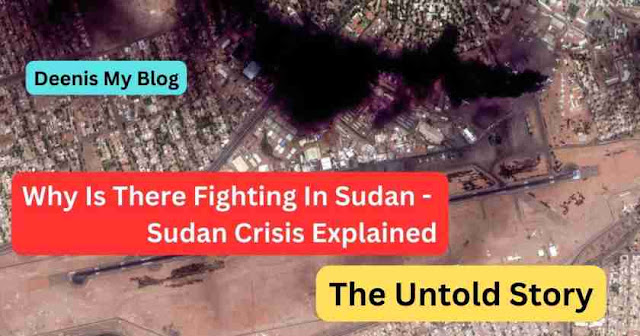Why Is There Fighting In Sudan - Sudan Crisis Explained
Why Is There Fighting In Sudan: Sudan Crisis Explained -
For years, Sudan has been plagued by conflict and violence. From the ongoing war in Darfur to the recent political turmoil that resulted in a military coup, it seems as though there is no end in sight for the country's troubles. So why is there so much fighting in Sudan? The answer is complex, rooted in historical tensions and modern-day power struggles.
 |
| Why Is There Fighting In Sudan - Sudan Crisis Explained |
One interesting statistic that sheds light on the severity of the crisis is the number of people who have been displaced from their homes due to violence. According to the United Nations High Commissioner for Refugees (UNHCR), over 2 million Sudanese citizens are currently living as refugees or internally displaced persons (IDPs). This staggering figure represents just a fraction of the total human cost of this long-running conflict.
Subscribe us on YouTube: Click Here
To truly understand what is happening in Sudan today, we need to look back at its tumultuous history. From colonialism to civil war, Sudan has faced numerous challenges throughout its existence as an independent nation. However, despite some progress toward peace and stability over the years, many of these underlying issues remain unresolved? setting the stage for continued unrest and upheaval. In this article, we will explore some of the key factors driving this crisis and consider possible solutions moving forward.
- Kisi Ka Bhai Kisi Ki Jaan Movie Download (720p, 1080p, 4K) Direct Link
- Pathan Full Movie Download [480p 720p 1080p 1440p 4k] | Pathaan 2023 Movie Download
Historical Background Of The Conflict In Sudan
Have you ever heard of the story about two brothers fighting over inheritance? The older one wanted a larger share, while the younger one felt that they should both have equal portions. This is similar to what happened in Sudan. There has been an ongoing conflict between the Arab Muslim north and the African Christian south for decades.
Sudan's history is marked by political instability, economic struggles, and cultural tension. Since gaining independence from Britain in 1956, various groups within Sudan have fought for autonomy or greater representation. In addition to this internal strife, external factors such as colonialism and international interference also played a role in shaping Sudan's current state.
The reason why there is fighting in Sudan can be traced back to several key events: first was the British policy of divide-and-rule which created artificial boundaries without considering tribal affiliations; second was the imposition of Sharia law by President Nimeiry who strengthened ties with Islamic fundamentalists leading to protests among non-Muslims; third was the discovery of oil reserves which intensified tensions between northern Arabs and southern Africans over natural resources distribution. These events set off a series of conflicts and civil wars that still persist today.
As we delve deeper into understanding why there is fighting in Sudan, it becomes clear that multiple factors are at play including historical grievances, resource competition, ethnic divisions, religious differences, and political power dynamics. All these issues will be explored further in our next section on 'factors contributing to the current crisis in Sudan.'
- Al Hilal vs Al Nassr score, result as Cristiano Ronaldo goal and penalty erased
- आप अपने सपने को कैसे हासिल करने जा रहे हैं? या अपने सपने की ओर पहला कदम कैसे उठाएं?
Factors Contributing To The Current Crisis In Sudan
The situation in Sudan is currently marked by a complex web of factors that have contributed to the ongoing crisis. To put it euphemistically, there are several challenges facing the country at present. One such challenge is related to economic instability, which has led to high inflation and food prices. This, in turn, has fuelled public discontent and protests against the government.
Another factor contributing to the current crisis in Sudan is political turmoil. The country's leadership has been unstable for years, with different factions vying for power and control. This has resulted in a lack of effective governance and policymaking, which has further exacerbated the economic problems faced by ordinary citizens.
Subscribe us on YouTube: Click Here
Perhaps one of the most significant contributors to the current crisis in Sudan is ethnic tensions between different groups within the country. These long-standing divisions have erupted into violence in recent times, resulting in large-scale displacement and suffering for many people. As we move forward, it will be essential to address these deep-rooted issues if any meaningful progress is to be made toward peace and stability.
Looking ahead, international intervention and potential solutions for the crisis will undoubtedly play an important role in shaping events on the ground. In particular, efforts must be made towards promoting dialogue between different parties involved while also addressing underlying causes of conflict such as poverty and inequality. Ultimately, only through sustained cooperation can we hope to bring lasting peace and prosperity to this troubled region.
International Intervention and Potential Solutions for the Sudan Crisis
International Intervention And Potential Solutions For The Crisis to address the ongoing crisis in Sudan, international intervention is vital. The United Nations (UN) has already taken some steps to help resolve this issue by sending peacekeeping forces to protect civilians and monitor human rights abuses. However, more needs to be done to bring an end to the violence.
One solution could be diplomatic negotiations between the government of Sudan and rebel groups. This approach would require both parties to come to the table with a willingness to compromise and make concessions. It may also involve mediation from neutral third-party countries or organizations such as the African Union (AU). Diplomatic negotiations could lead to a sustainable peace agreement that addresses the root causes of conflict while respecting the rights of all citizens.
Another potential solution is investing in economic development programs that benefit marginalized communities. By promoting job creation, poverty reduction, and access to basic services like healthcare and education, these programs can help alleviate tensions caused by inequality and lack of opportunities. International donors can work with local governments and civil society organizations in Sudan to design and implement these initiatives effectively.
In summary, there are several ways international actors can contribute to resolving the crisis in Sudan. Whether through diplomatic dialogue or targeted investments in economic development, it will take collective efforts from various stakeholders to achieve lasting peace in this troubled region.
Subscribe us on YouTube: Click Here
Conclusion
Well folks, it looks like Sudan can't catch a break. This African nation has been plagued with conflict for years and the current crisis certainly isn't helping matters. But why is there so much fighting in Sudan? Let's take a look.
Firstly, we need to understand the historical background of this conflict. It all started back in 1956 when Sudan gained independence from Britain. Since then, various ethnic groups have been vying for power and resources, leading to violent clashes and political instability.
But what are the factors contributing to the current crisis? Well, there's no easy answer but some key issues include economic struggles, corruption within the government, and tensions between different regions of the country.
So where do we go from here? International intervention could help but ultimately it's up to those involved in the conflict to come together and find a solution. Until then, let's hope that Sudan can finally find peace - they deserve it after all these years of turmoil.

%20(1).jpg)


.jpg)
